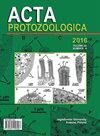Morphology and Ontogenesis of Hemiholosticha pantanalensis nov. spec. (Ciliophora, Hypotrichia, Psilotrichidae)
IF 1.2
4区 生物学
Q4 MICROBIOLOGY
引用次数: 2
Abstract
The morphology and ontogenesis of a new psilotrichid ciliate, Hemiholosticha pantanalensis, were studied using live observation, protargol impregnation, and scanning electron microscopy. Diagnostic features of the new species include: a medium-sized, almost circular to broadly obovate body with a short anterior projection; two macronuclear nodules with a single micronucleus in between; a total of about 35 cirri arranged in three ventral, one postoral, one right and one left marginal row; three dorsal kineties extending along prominent ribs; an adoral zone occupying about 60% of body length; and intracellular, eyespot-bearing, green algae almost filling the body. The ontogenesis of H. pantanalensis follows the psilotrichid mode, being a mixture of features found not only in various hypotrich taxa but also in other spirotrich groups. Specifically, the oral primordium develops in a deep pouch as in euplotids and oligotrichs, the anlage for the undulating membranes does not produce cirri as in euplotids and some schmidingerothrichids, and the longitudinal ventral cirral row R3 develops from two anlagen as in some amphisiellids and kahliellids. Since psilotrichids are classified in a polytomy of main hypotrich lineages in 18S rRNA gene phylogenies, some of their ontogenetic features might be ancient spirotrich plesiomorphies while others might be homoplasies. Address for correspondence: Peter Vďačný, Department of Zoology, Faculty of Natural Sciences, Comenius University in Bratislava, Ilkovičova 6, 842 15 Bratislava, Slovak Republic; E-mail: peter. vdacny@uniba.skpantanalensis Hemiholostica nov.spec.的形态和个体发生
采用活体观察、原targol浸渍和扫描电镜等方法研究了一种新的拟纤毛虫(Hemiholosticha pantanalensis)的形态和个体发生。新种的诊断特征包括:中等大小,几乎圆形到宽倒卵形的身体,前突短;两个大核结节,中间有一个微核;共35个左右,排列在3个腹、1个后、1个右、1个左边缘行;三个背侧运动沿着突出的肋骨延伸;占体长约60%的口腔区;细胞内,眼斑,绿藻几乎充满了身体。H. pantanalensis的个体发生遵循原螺旋体模式,不仅在各种原螺旋体类群中发现,而且在其他螺旋体类群中也发现。具体来说,口腔原基在一个深袋中发育,如整倍体和少毛体,波动膜的支原体不产生卷毛,如整倍体和一些半毛毛体,纵向腹侧卷毛行R3由两个角原发育,如一些两栖体和kahliliids。由于在18S rRNA基因系统发育中,拟螺虫被划分为主要的亚营养谱系,因此它们的个体发育特征可能是古代螺虫的多形性,而另一些可能是同源性。通信地址:Peter Vďačný,布拉迪斯拉发夸美纽斯大学自然科学学院动物学系,ilkovi ova 6, 842 15布拉迪斯拉发,斯洛伐克共和国;电子邮件:彼得。vdacny@uniba.sk
本文章由计算机程序翻译,如有差异,请以英文原文为准。
求助全文
约1分钟内获得全文
求助全文
来源期刊

Acta Protozoologica
生物-微生物学
CiteScore
2.00
自引率
0.00%
发文量
8
审稿时长
>12 weeks
期刊介绍:
Acta Protozoologica - International Journal on Protistology - is a quarterly journal that publishes current and comprehensive, experimental, and theoretical contributions across the breadth of protistology, and cell biology of Eukaryote microorganisms including: behaviour, biochemistry and molecular biology, development, ecology, genetics, parasitology, physiology, photobiology, systematics and phylogeny, and ultrastructure. It publishes original research reports, critical reviews of current research written by invited experts in the field, short communications, book reviews, and letters to the Editor.
 求助内容:
求助内容: 应助结果提醒方式:
应助结果提醒方式:


